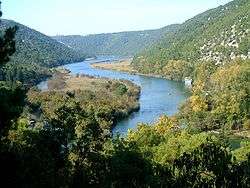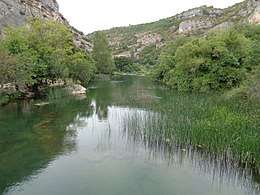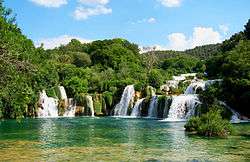Krka (Croatia)
Krka (pronounced [kr̩ka]) is a river in Croatia's Dalmatia region, known for its numerous waterfalls. It is 73 km (45 mi) long and its basin covers an area of 2,088 km2 (806 sq mi).[1] It was known in ancient Greek as Kyrikos, or may be also as Catarbates (literally "steeply falling")[2] by the ancient Greeks, it was known to the ancient Romans as Titius, Corcoras, or Korkoras.
| Krka | |
|---|---|
 | |
| Location | |
| Country | Croatia |
| Physical characteristics | |
| Mouth | |
• location | Adriatic Sea |
• coordinates | 43.7198°N 15.8526°E |
| Length | 73 km (45 mi)[1] |
| Basin size | 2,088 km2 (806 sq mi)[1] |

.jpg)

Course
The river has its source near the border of Croatia with Bosnia and Herzegovina, at the foot of the Dinara mountain. After meandering through the Krčić canyon, it enters the karst valley of Knin through the Krčić waterfall of 25 m (82 ft). At the foot of the second, called the Topoljski waterfall, of these is a spring in a cave with 150 m (490 ft) of passage.[3] The river then flows through the valley, where it is fed by the Kosovčica on the left and the Orašnica and the Butižnica on the right, passing the Fortress of Knin between the last two on the way, and into the main canyon.
What follows belongs to the Krka National Park. The first waterfall there is the 6 m (20 ft) high Bilušića waterfall, which is followed by twice its height in cascades. They lead to the Brljansko lake with a waterfall in its middle, of nearly equal height. At the end of the second half of the lake begin the Manojlovački waterfalls a series of waterfalls and cascades with a total elevation of 60 m (200 ft), half of which is from the last one. Here, on the right bank, lie the Roman ruins of Burnum. At the far end of the canyon are the ruins of the medieval castles of Nečven on the left and Trošenj opposite it. Beyond it is the Serbian Orthodox Krka monastery. Further down, an extensive cascade system ends in the 20 m (66 ft) high Roški waterfall. Still further, the river forms the 7 km (4.3 mi) Visovačko lake, with the Franciscan order Visovac Monastery on the island in the middle of the lake. The lake ends at the confluence of the Krka and its largest tributary, the Čikola. At that point, they form the Skradinski waterfalls, a long series with a total height of 45 m (148 ft).
From this point on, the river is navigable from the sea. The river flows past the town of Skradin on the right, flowing into the 5 km (3.1 mi) wide Prokljansko lake, into which the Guduča river flows on the right. After that, the river empties into the 10 km (6.2 mi) long Bay of Šibenik, which is connected to the Adriatic Sea by the Canal of St. Anthony, at the Fortress of St. Nicholas.[4]
Development
This area is also the location of the first hydroelectric power station using alternate current in Croatia, the Jaruga Hydroelectric Power Plant. This plant started supplying power to the nearby city of Šibenik in 1895.
Pollution
Parts of the Krka river were heavily mined during the Yugoslav Wars. As of 2016, many fields bordering the canyon between Visovačko lake and Prokljansko lake on the right bank, and between Nečven and Visovačko lake on the left bank, have yet to be demined. Tourist areas and paved roads are no longer affected.[5]
See also
References
- Statistical Yearbook of the Republic of Croatia 2017 (PDF) (in Croatian and English). Zagreb: Croatian Bureau of Statistics. December 2017. p. 47. ISSN 1333-3305. Retrieved 23 May 2018.
- Wilkes, J. The Illyrians. Blackwell, 1992. 101.
- Božičević, Srećko (2015). "Špilja Izvor Krke". sv-mihovil.hr. Hrvatski planinarski klub Sveti Mihovil. Archived from the original on 27 March 2016. Retrieved 5 January 2017.CS1 maint: BOT: original-url status unknown (link)
- "Prirodna baština". npkrka.hr. Retrieved 5 January 2017.
- "MIS Portal". hcr.hr. Hrvatski centar za razminiranje. Retrieved 5 January 2017.
Literature
- Don Krsto Stošić, Rijeka Krka sa 54 slike, Tisak Pučke tiskare u Šibeniku, Šibenik Croatia 1927

